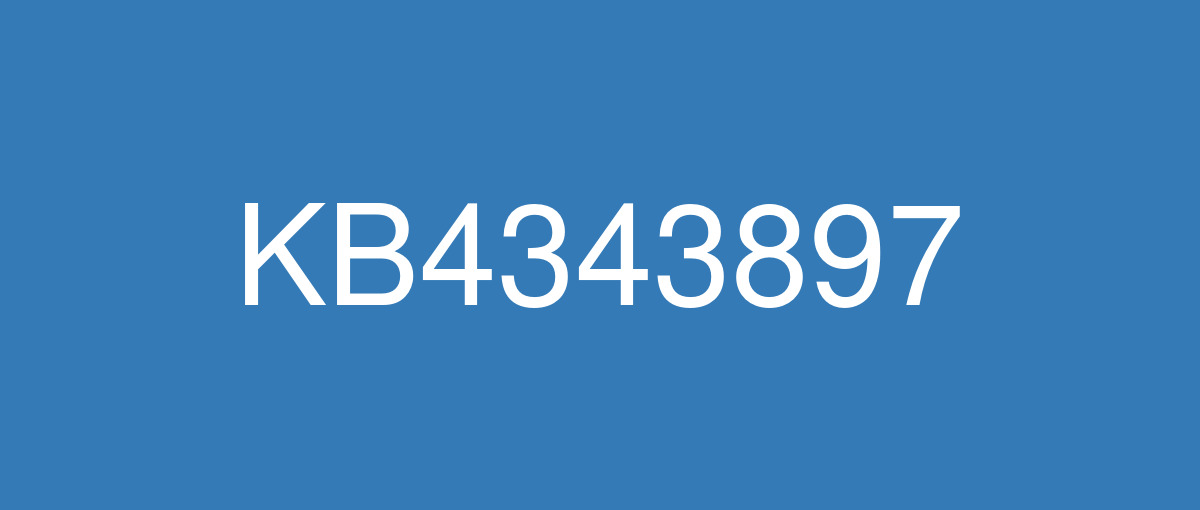KB4343897

詳細情報
| KB番号 | KB4343897 |
|---|---|
| リリース日 | 2018/08/14 |
| Windowsバージョン | Windows 10 1709 |
| ビルド番号 | 16299.611 |
| URL(英語) | https://support.microsoft.com/en-us/help/4343897 |
| URL(日本語) | https://support.microsoft.com/ja-jp/help/4343897 |
| ダウンロード | Microsoft Update Catalog |
ハイライト(英語)
改良点(英語)
Provides protections against a new speculative execution side-channel vulnerability known as L1 Terminal Fault (L1TF) that affects Intel® Core® processors and Intel® Xeon® processors (CVE-2018-3620 and CVE-2018-3646). Make sure previous OS protections against Spectre Variant 2 and Meltdown vulnerabilities are enabled using the registry settings outlined in the Windows Client and Windows Server guidance KB articles. (These registry settings are enabled by default for Windows Client OS editions, but disabled by default for Windows Server OS editions.)
Addresses an issue that causes high CPU usage that results in performance degradation on some systems with Family 15h and 16h AMD processors. This issue occurs after installing the June 2018 or July 2018 Windows updates from Microsoft and the AMD microcode updates that address Spectre Variant 2 (CVE-2017-5715 – Branch Target Injection).
Updates support for the draft version of the Token Binding protocol v0.16.
Addresses an issue that causes Device Guard to block some ieframe.dll class IDs after the May 2018 Cumulative Update is installed.
Ensures that Internet Explorer and Microsoft Edge support the preload="none" tag.
Addresses an issue that displays “AzureAD” as the default domain on the sign-in screen after installing the July 24, 2018 update on a Hybrid Azure AD-joined machine. As a result, users may fail to sign in in Hybrid Azure AD-joined scenarios when users provide only their username and password.
Addresses an issue that adds additional spaces to content that's copied from Internet Explorer to other apps.
Addresses a vulnerability related to the Export-Modulemember() function when used with a wildcard (*) and a dot-sourcing script. After installing this update, existing modules on devices that have Device Guard enabled will intentionally fail. The exception error is “This module uses the dot-source operator while exporting functions using wildcard characters, and this is disallowed when the system is under application verification enforcement”. For more information, see https://portal.msrc.microsoft.com/en-US/security-guidance/advisory/CVE-2018-8200 and https://aka.ms/PSModuleFunctionExport .
Addresses an issue that was introduced in the July 2018 .NET Framework update. Applications that rely on COM components were failing to load or run correctly because of “access denied,” “class not registered,” or “internal failure occurred for unknown reasons” errors.
Addresses a vulnerability issue by correcting the way that the .NET Framework handles high-load or high-density network connections. For more information, see CVE-2018-8360.
Security updates to Windows Server.
既知の不具合(英語)
Some non-English platforms may display the following string in English instead of the localized language: ”Reading scheduled jobs from file is not supported in this language mode.” This error appears when you try to read the scheduled jobs you've created and Device Guard is enabled | After evaluation, Microsoft has determined that this is a low probability and a low-risk issue, and we will not provide a solution at this time for Windows 10, version 1709. If you believe that you are affected by this issue, please contact Microsoft Support. |
When Device Guard is enabled, some non-English platforms may display the following strings in English instead of the localized language:
| After evaluation, Microsoft has determined that this is a low probability and a low-risk issue, and we will not provide a solution at this time for Windows 10, version 1709. If you believe that you are affected by this issue, please contact Microsoft Support. |
After installing this update, Windows no longer recognizes the Personal Information exchange (PFX) certificate that’s used for authenticating to a Wi-Fi or VPN connection. As a result, Microsoft Intune takes a long time to deliver user profiles because it doesn’t recognize that the required certificate is on the device. | This issue is resolved in KB4464217. |
ハイライト(日本語)
ありません
改良点(日本語)
Intel® Core® プロセッサおよび Intel® Xeon® プロセッサに影響する L1 Terminal Fault (L1TF) という新しい投機的実行サイドチャネルの脆弱性に対する保護機能を提供します (CVE-2018-3620 および CVE-2018-3646)。 Windows クライアントと Windows Server 向けガイダンスのサポート技術情報に記載されているレジストリ設定を使用してスペクター バリアント 2 およびメルトダウンの脆弱性に対する以前の OS の保護機能が有効になっていることを確認します (Windows クライアント OS エディションでは、これらのレジストリ設定は既定で有効ですが、Windows Server OS エディションでは既定で無効です)。
ファミリ 15h および 16h AMD プロセッサを搭載した一部のシステムで、CPU 使用率が高くなり、パフォーマンスが低下する問題を修正します。 この問題は、スペクター バリアント 2 (CVE-2017-5715 – ブランチ ターゲット インジェクション) を解決するマイクロソフトからリリースされた 2018 年 6 月または 2018 年 7 月の Windows 更新プログラムと AMD マイクロコードの更新プログラムをインストールした後に発生します。
Token Binding プロトコル v0.16 のドラフト版のサポートを更新します。
2018 年 5 月の累積的な更新プログラムをインストールした後に、Device Guard で一部の ieframe.dll クラス ID がブロックされる問題を修正します。
Internet Explorer と Microsoft Edge で preload="none" タグがサポートされるようになります。
ハイブリッド Azure AD 参加マシンに 2018 年 7 月 25 日リリースの更新プログラムをインストールした後、サインイン画面の既定のドメインとして “AzureAD” が表示される問題を修正します。 この問題により、ハイブリッド Azure AD 参加シナリオでユーザーがユーザー名とパスワードのみを指定した場合にサインインできないことがあります。
Internet Explorer から他のアプリケーションにコピーされたコンテンツにスペースが追加される問題を修正します。
ワイルドカード (*) およびドットソーシング スクリプトを使用した場合の Export-Modulemember() 関数に関連する脆弱性を解決します。 この更新プログラムをインストールすると、Device Guard が有効なデバイスの既存のモジュールは意図的に失敗します。 “This module uses the dot-source operator while exporting functions using wildcard characters, and this is disallowed when the system is under application verification enforcement” という例外エラーが発生します。 詳細については、https://portal.msrc.microsoft.com/ja-jp/security-guidance/advisory/CVE-2018-8200 と https://aka.ms/PSModuleFunctionExport を参照してください。
2018 年 7 月の .NET Framework の更新プログラムで導入された問題を修正します。 “アクセスが拒否された”、“クラスが登録されていない”、または “不明な理由で内部エラーが発生した” ため、COM コンポーネントに依存するアプリケーションの読み込みまたは実行に失敗しました。
.NET Framework が高負荷または高密度ネットワーク接続を処理する方法を修正することにより、脆弱性の問題を解決します。 詳細については、CVE-2018-8360 を参照してください。
Windows Server のセキュリティ更新プログラム。
既知の不具合(日本語)
ありません